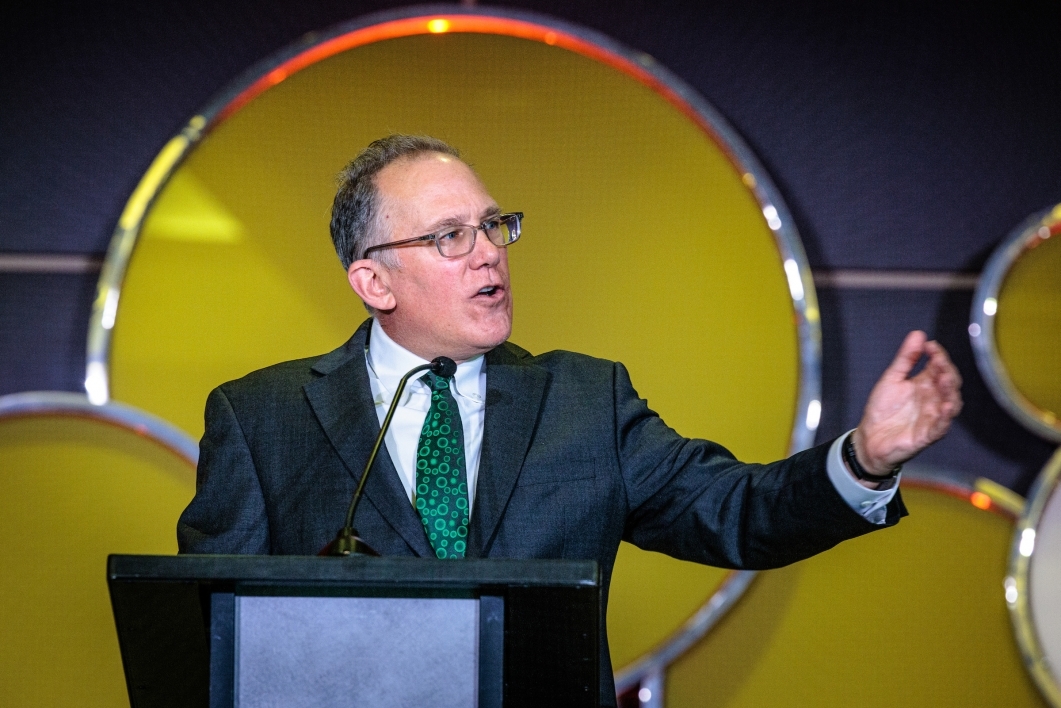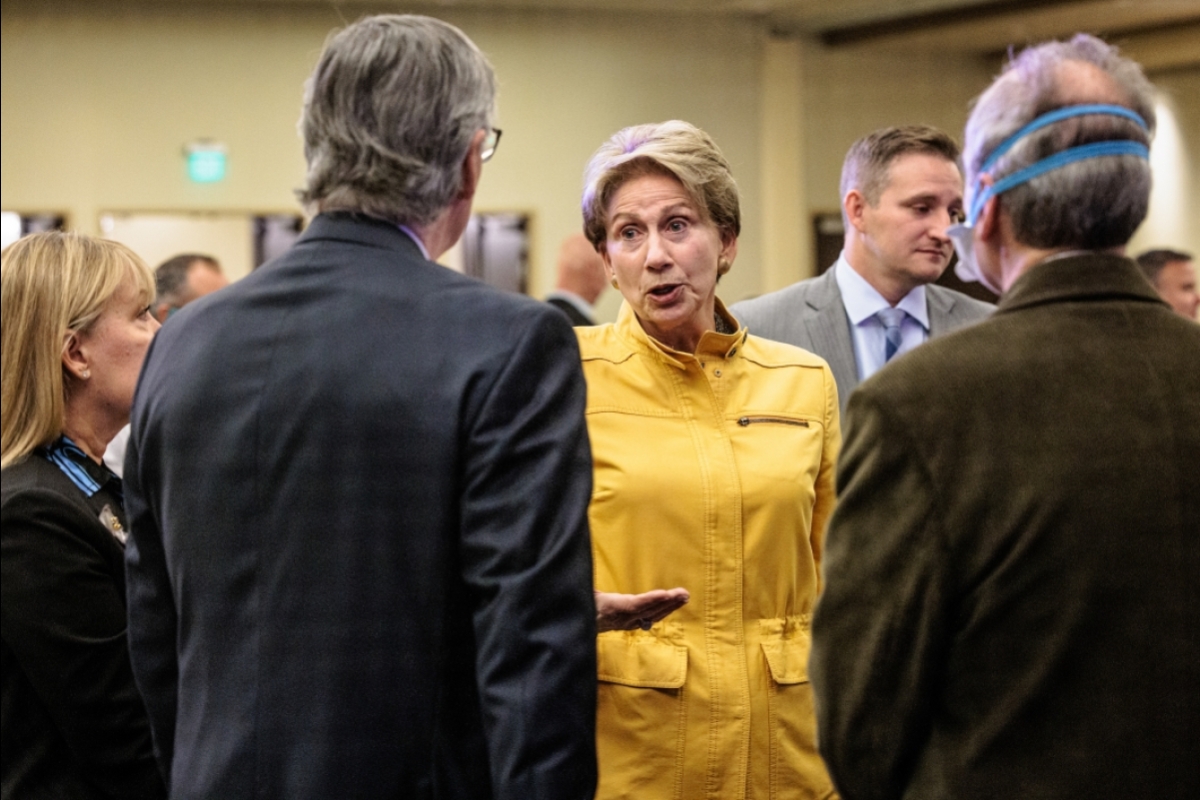Strong recovery predicted for nation, state, Phoenix by ASU economic forecaster

The United States, Arizona and the Phoenix metro area have all bounced back from the steep but short economic recession induced by the pandemic, and the outlook is good, according to Arizona State University’s economic forecaster.
Lee McPheters, research professor of economics and director of the JPMorgan Chase Economic Outlook Center at ASU, spoke at the annual ASU/PNC Bank Economic Forecast Luncheon, which was sponsored by the Department of Economics in the W. P. Carey School of Business at the Renaissance Phoenix Downtown Hotel on Wednesday.
“The main message is that the U.S. and Arizona economies were hit hard by the pandemic, but we expect a strong economy into 2022,” he said.
“We’re going to replace all the lost jobs by the end of 2021.”
McPheters said that Arizona lost more than 331,000 jobs in March and April of 2020 – more than the entire Great Recession that extended over several years.
“But after that, we began bouncing back, and we’ve added jobs every month since,” he said, noting that all of the lost jobs in the pandemic recession were recovered by the first quarter of 2021.
“There’s a good chance we’ll see an all-time high employment in Arizona of 3 million by the end of this year.”
The Phoenix economy has continued to move away from reliance on real estate and is much more diverse than it was before.
— Lee McPheters, director of the JPMorgan Chase Economic Outlook Center at ASU
He expects the state to add 117,000 jobs in 2022 – the best year for job growth and the first year to add more than 100,000 jobs since 2006.
“What’s driving employment recovery? The service sector,” he said.
More than 80% of new jobs came from food service, transportation and warehousing, retail, the professional and technology fields and health care.
The Phoenix metro area added 77,000 new jobs in 2021 and ranks third nationwide in job growth for transportation/warehousing and professional/technical, he said.
“The Phoenix economy has continued to move away from reliance on real estate and is much more diverse than it was before,” he said.
McPheters expects the white-hot housing market to stabilize. In 2021, single-family housing permits increased 23% in Arizona, compared with 17% nationwide.
The average home price in Phoenix increased 33.3% in a year but will likely grow at a steadier 4% to 6% going forward, he said.
The average home price in Phoenix is $474,000, which is still less than most other metro areas in the West, including Denver; Austin, Texas; Riverside, California; Provo, Utah; and Seattle.
“This is not the same 80,000-single-family-permits we saw in the housing boom of the mid-2000s, but it is a steady, sustainable trend in home building that is beneficial for the Arizona economy,” he said.
McPheters sees potential risks for Arizona in several areas: pandemic uncertainty, supply chain issues, affordable housing and federal policy.
“I think everyone would agree we need to continue to work on educational issues,” he said.
“Maybe we won’t be No. 1 in terms of spending philosophy, but this is a state that should be ranked in the top half for education, now the lower half.”
Nationally, the economy remains in recovery from the pandemic recession, but there are still weak spots, according to Augustine “Gus” Faucher, chief economist for the PNC Financial Services Group, who spoke at the luncheon.
Across the U.S., employment is still down by more than 4 million, and 2% of the population has dropped out of the labor force, he said.
“Before the pandemic, 63% of all adults were in the labor force, and now it’s less than 62%,” he said. “Some took early retirement. Some are concerned about the health situation and are unwilling to put themselves into that situation.
“Some are having child-care difficulties, with virtual school and child care closed. And there are those who received stimulus payments or extra unemployment benefits and are not ready to come back.
“I do expect many of those people will gradually return to the labor force over the next year and half or so, but it is going to remain a difficult situation for people who are trying to hire.”
Another weak spot is consumer spending on services, such as education, health care, financial services and travel, which fell 15% during the pandemic and is still 2% below pre-pandemic levels.
Meanwhile, consumer spending on durable goods, such as appliances and cars, fell by about 3% during the pandemic but is now 20% higher than pre-pandemic levels, even with the lack of car inventory. Consumer spending accounts for about two-thirds of the U.S. economy.
Both McPheters and Faucher downplayed the likelihood of the current increase in inflation continuing long term.
“The Phoenix inflation rate topped 7% year over year, which is startling,” McPheters said.
But he said that while the consumer price index rose 8.2%, average weekly wages are up more than 12%.
“What that means is that in spite of inflation and higher prices, we still have expansion of purchasing power,” he said.
Faucher said that inflation is likely to increase at about 2% a year going forward.
“We had inflation at below 2% a year over the past decade,” he said. “The financial markets don’t think that the higher inflation we’ve seen recently will become embedded into the economy.”
Lawrence Summers, the Charles W. Eliot University Professor and former president of Harvard University, said that federal stimulus money led to a surge in household income, which led to inflation.
“Right now we’re looking at an economy that is quite strong but at a danger of overheating,” he said. “A bathtub that is overflowing is a real problem.”
The Fed should raise interest rates over the next year to slow down growth, he said.
Summers, former secretary of the Treasury, said that some people believe that with the size of the budget deficit, the U.S. should not engage in significant expenditures.
“I think we’re a better country if we collect taxes more efficiently and if we support an energy transition to a greener economy,” he said.
“I think it’s insane that it takes 20 minutes longer to fly from Boston to Washington than it did 20 years ago because of decaying infrastructure.
“I believe it is important that we make very substantial public investments into the future of our country, but I also believe that as we make those investments, it is enormously important that we do so as efficiently and effectively as possible.”
Top photo: Lee McPheters, research professor of economics and director of the JPMorgan Chase Economic Outlook Center at ASU, spoke at the annual ASU/PNC Bank Economic Forecast Luncheon at the Renaissance Phoenix Downtown Hotel on Dec. 8. He predicted that Arizona will add about 117,000 jobs in 2022. Photo by Charlie Leight/ASU News
More Business and entrepreneurship
Sustainability leader and ASU alum honored for transforming business with a people-first approach
Long before Jim Fish ('86 BS in accountancy) became president and CEO of WM — formally Waste Management — in 2016, he recognized that the higher he climbed the corporate ladder, the greater the…

ASU business students take on the big leagues
Each year, sports fans from across the country flock to Arizona to attend major events like the Waste Management Phoenix Open, Fiesta Bowl and Cactus League Spring Training. These mega-events…

With help from ASU and a viral TikTok, an entrepreneur soars
Nearly five years ago, Ruben Trujillo saw his entrepreneurial dream slipping away as he wondered how he would pay his rent.Now, Trujillo’s business, Café Emporos, is featured on a national TV…




